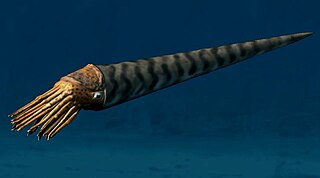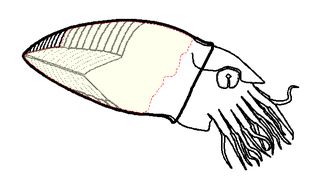
Ammonoids are a group of extinct marine mollusc animals in the subclass Ammonoidea of the class Cephalopoda. These molluscs, commonly referred to as ammonites, are more closely related to living coleoids than they are to shelled nautiloids such as the living Nautilus species. The earliest ammonites appeared during the Devonian, with the last species vanishing during or soon after the Cretaceous–Paleogene extinction event.

Nautiloids are a group of marine cephalopods (Mollusca) which originated in the Late Cambrian and are represented today by the living Nautilus and Allonautilus. Fossil nautiloids are diverse and speciose, with over 2,500 recorded species. They flourished during the early Paleozoic era, when they constituted the main predatory animals. Early in their evolution, nautiloids developed an extraordinary diversity of shell shapes, including coiled morphologies and giant straight-shelled forms (orthocones). Only a handful of rare coiled species, the nautiluses, survive to the present day.

Orthoceras is a genus of extinct nautiloid cephalopod restricted to Middle Ordovician-aged marine limestones of the Baltic States and Sweden. This genus is sometimes called Orthoceratites. Note it is sometimes misspelled as Orthocera, Orthocerus or Orthoceros.

Endocerida is an extinct nautiloid order, a group of cephalopods from the Lower Paleozoic with cone-like deposits in their siphuncle. Endocerida was a diverse group of cephalopods that lived from the Early Ordovician possibly to the Late Silurian. Their shells were variable in form. Some were straight (orthoconic), others curved (cyrtoconic); some were long (longiconic), others short (breviconic). Some long-shelled forms like Endoceras attained shell lengths close to 6 metres (20 ft). The related Cameroceras is anecdotally reported to have reached lengths approaching 9 metres (30 ft), but these claims are problematic. The overwhelming majority of endocerids and nautiloids in general are much smaller, usually less than a meter long when fully grown.

Orthocerida, also known as the Michelinocerida, is an order of extinct orthoceratoid cephalopods that lived from the Early Ordovician possibly to the Late Triassic. A fossil found in the Caucasus suggests they may even have survived until the Early Cretaceous, and the Eocene fossil Antarcticeras is sometimes considered a descendant of the orthocerids although this is disputed. They were most common however from the Ordovician to the Devonian.

The Bactritida are a small order of more or less straight-shelled (orthoconic) cephalopods that first appeared during the Emsian stage of the Devonian period with questionable origins in Pragian stage before 409 million years ago, and persisted until Carnian pluvial event in the upper middle Carnian stage of the Triassic period. They are considered ancestors of the ammonoids, as well as of the coleoids.

Neocephalopods are a group of cephalopod mollusks that include the coleoids and all extinct species that are more closely related to extant coleoids than to the nautilus. In cladistic terms, it is the total group of Coleoidea. In contrast, the palcephalopoda are defined as the sister group to the neocephalopoda.

Pseudorthocerida is an order of generally straight longiconic orthoceratoids with a subcentral to marginal cyrtochoanitic siphuncle composed of variably expanded segments which may contain internal deposits that may develop into a continuous parietal lining.. Cameral deposits are common and concentrated ventrally. Apices typically have a slight to moderate exogastric curvature
Tienocerasis an orthoceratoid genus from the Permian of China (Hunan). Orthoceratoids are slender conical or near cylindrical, orthoconic, nautiloid cephalopods from the Paleozoic. Nautiloids, which include a number of different extinct orders, were far more diverse and numerous in the past, but are represented today by only two closely related genera.
The Genus Hemichoanella is a small, extinct, orthoconic nautiloid cephalopod from the Lower Ordovician of Western Australia assigned to the orthoceratoid family, Baltoceratidae. Hemichoanella and the Baltoceratidae are part of the subclass of once diverse and numerous shelled cephalopods known as the Nautiloidea.
Bactroceras is a genus of orthoceratoid cephalopods that lived during the early Middle Ordovician, from about 472—464 mya, existing for approximately 8 million years.
Cyptendoceras is an extinct nautiloid cephalopod included in the family Ellesmeroceratidae that lived in what would be North and South America during the latter part of the Early Ordovician from about 475 – 472 mya, existing for approximately 3 million years.
Rioceras is an extinct genus of orthocerid cephalopods of the family Baltoceratidae that lived in what would be North America during the Early Ordovician from 480—472 mya, existing for approximately 8 million years.

Orthoceratoidea is a major subclass of nautiloid cephalopods. Members of this subclass usually have orthoconic (straight) to slightly cyrtoconic (curved) shells, and central to subcentral siphuncles which may bear internal deposits. Orthoceratoids are also characterized by dorsomyarian muscle scars, extensive cameral deposits, and calciosiphonate connecting rings with a porous and calcitic inner layer.
Dissidocerida is an order of Early Ordovician to the Early Silurian orthoceratoid cephalopods in which the siphuncle has a continuous lining or a longitudinal rod-like structure within.
The cephalopods have a long geological history, with the first nautiloids found in late Cambrian strata, and purported stem-group representatives present in the earliest Cambrian lagerstätten.
Plectronoceratoidea is a superorder or subclass containing primitive nautiloids from the Late Cambrian and Early Ordovician. This group is best considered a paraphyletic grade of early cephalopods, as it contains the ancestors of subsequent post-Cambrian cephalopod orders.
Murrayoceras is a nautilid cephalopod included in the orthocerid family Baltoceratidae, widespread in the Middle Ordovician of North America, characterized by a depressed orthoconic shell with a subtriangular cross section and flattened venter and a proportionally large ventral siphuncle, 0.15 to 0.3 the dorso-ventral shell diameter. Septa are close spaced with sutures forming broad lobes on the upper flanks and ventral surface.

Bisonocerida is an order of Ordovician to Silurian nautiloid cephalopods. Members of this order were originally placed in the order Endocerida, but later investigation argued that this broad usage of Endocerida was a polyphyletic assemblage encompassing two different groups of independent origin. Bisonocerida was differentiated from Endocerida in 2012 in order to resolve this issue.
Antarcticeras is an extinct genus of enigmatic cephalopod from the Eocene of Antarctica. It contains a single species, A.nordenskjoeldi. It is either considered the last of the "orthocone"-type cephalopods, the only member of its subclass Paracoleoidea & a descendant of the orthoceratids, and a remarkable example of convergent evolution with coleoid cephalopods, or an oegospid squid and a transitional form in the development of the modern squid gladius, of which it is the only preserved example.












